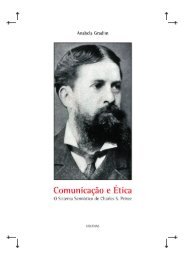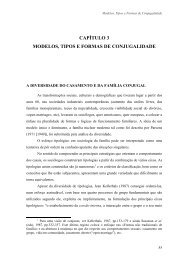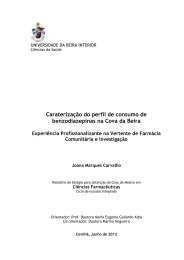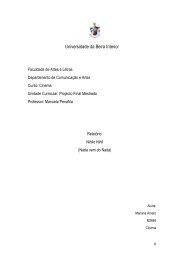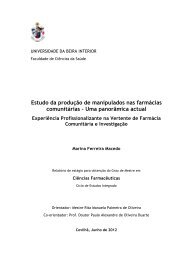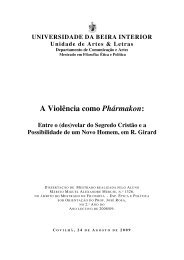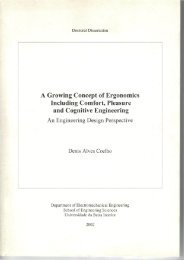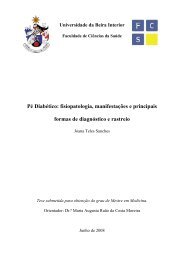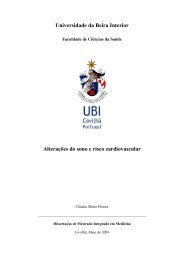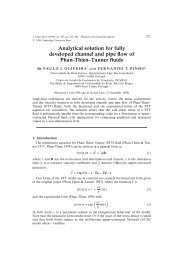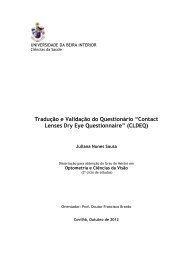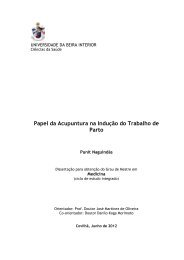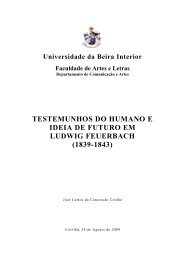Tese_Tânia Vieira.pdf - Ubi Thesis
Tese_Tânia Vieira.pdf - Ubi Thesis
Tese_Tânia Vieira.pdf - Ubi Thesis
Create successful ePaper yourself
Turn your PDF publications into a flip-book with our unique Google optimized e-Paper software.
Chapter III – Results and Discussion<br />
Table 5 – Different nanoparticles and their concentrations to perform the cytotoxic assays.<br />
Low<br />
Nanoparticles<br />
Identification<br />
concentration<br />
(µg/mL)<br />
MIC (µg/mL)<br />
High<br />
concentration<br />
(µg/mL)<br />
1 Chitosan/dextran nanoparticles 20.0000 107.1000 428.6000<br />
2<br />
3<br />
4<br />
5<br />
Chitosan/dextran nanoparticles with<br />
AgNPs (NaBH 4)<br />
Chitosan/dextran nanopartices with<br />
AgNPs (C 6H 8O 6)<br />
Chitosan/dextran nanoparticles with<br />
AgNO 3 and NaBH 4<br />
Chitosan/dextran nanoparticles with<br />
AgNO 3 and C 6H 8O 6<br />
0.3000 1.5000 6.0000<br />
0,1875 3.0000 6.0000<br />
1,6243 11.7500 42.5000<br />
1,6243 23.5000 42.5000<br />
6 AgNPs (NaBH 4) 2,5000 10.0000 40.0000<br />
7 AgNPs (C 6H 8O 6) 2,5000 10.0000 40.0000<br />
Cell adhesion and proliferation was observed by using an inverted light microscope after<br />
24 and 48 h (figure 13 and 14). In the negative control (K - ) cells were viable, appearing with<br />
stellate geometry and showing slender lamellar expansions that joined neighboring cells. In the<br />
positive control (K + ), dead cells were seen with their spherical characteristic form. For the cells<br />
in contact with the different concentrations of nanoparticles, no toxic effects were observed<br />
when nanoparticles in low or MIC concentrations were put in contact with cells during 24 and 48<br />
h. This can be depicted in figure 13, where cells were similar to that of the K + . For the high<br />
concentrations of nanoparticles almost no toxic effects were obtained, except for the particles<br />
presented in figure 14 A, 4 (Chitosan/dextran with AgNO 3 and with C 6 H 8 O 6 as reducing agent) and<br />
5 (Chitosan/dextran with AgNO 3 and with NaBH 4 as reducing agent) that presented some dead<br />
cells. In the figure 14 B are presented the results obtained for the cells in contact with the<br />
supernatants obtained from the nanoparticles washing, in which some adhered cells and some<br />
dead cells were observed, indicating some toxic effects on the cells, during the period of<br />
exposure to the supernatants.<br />
44



